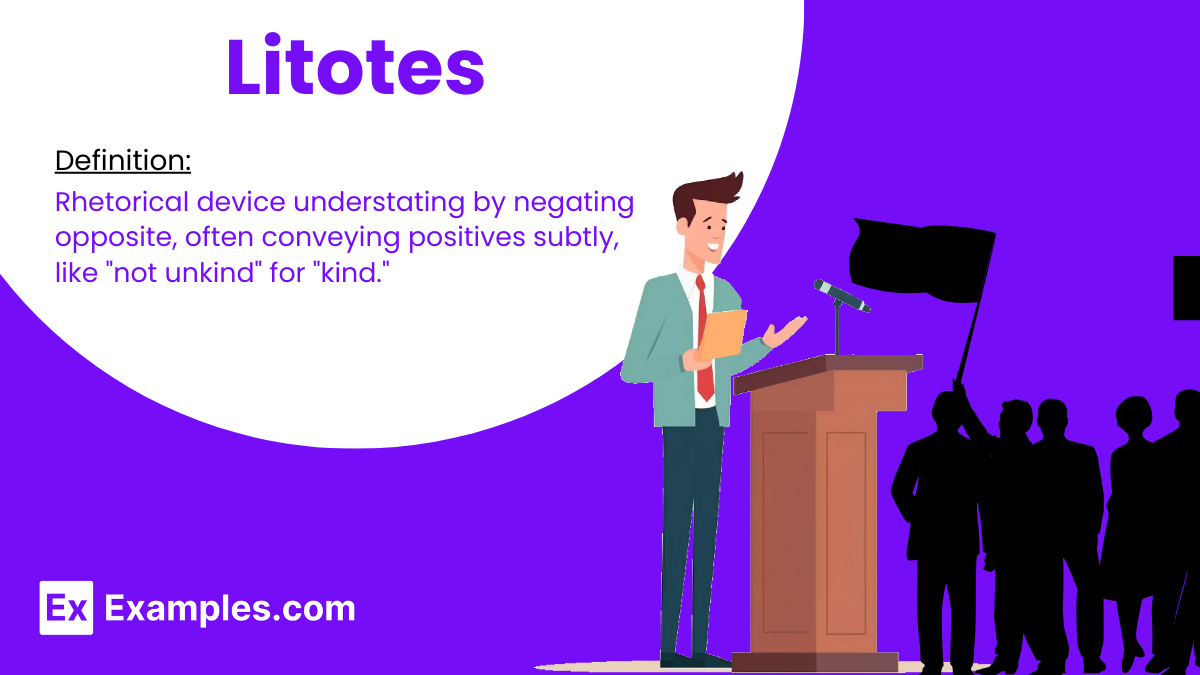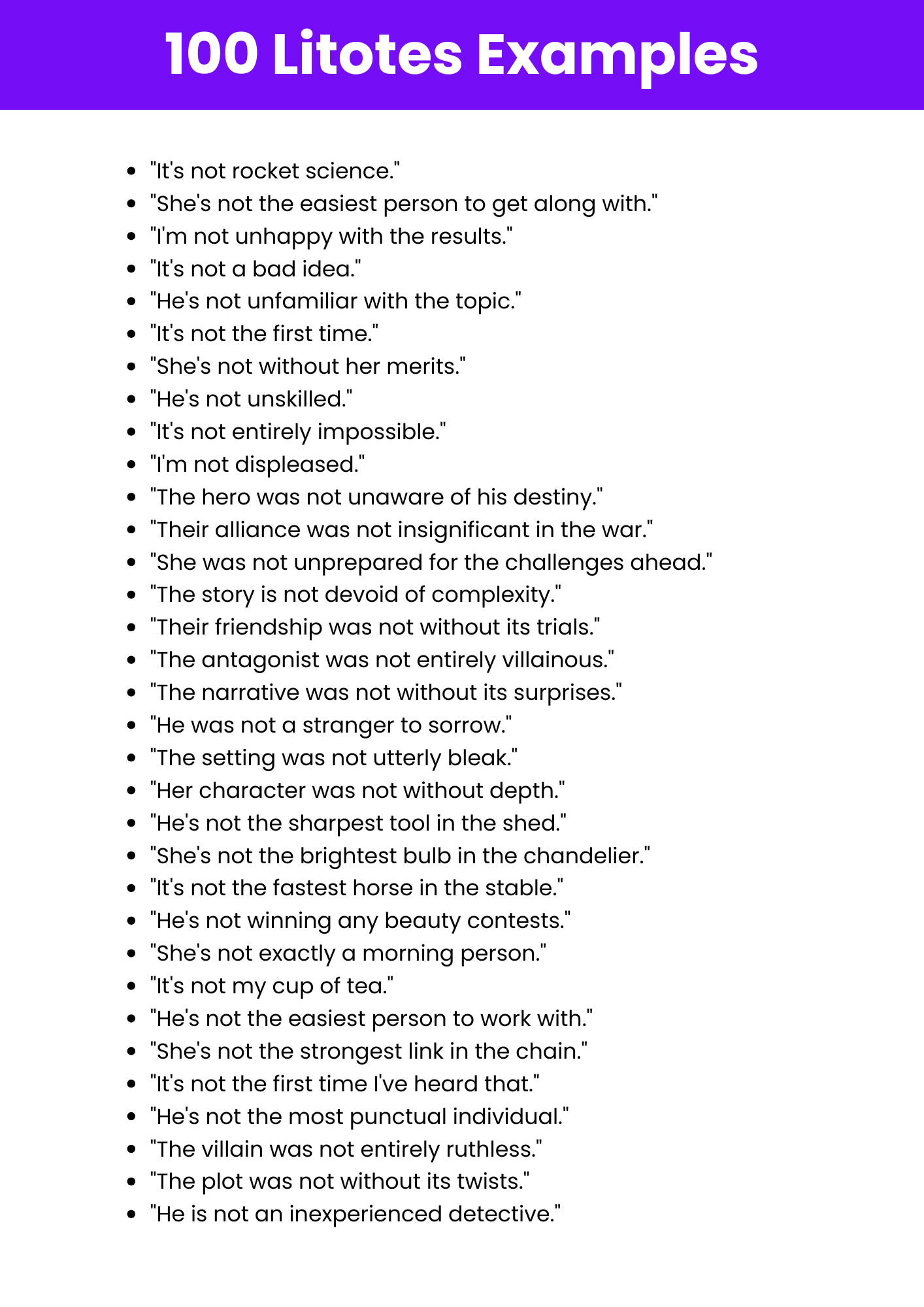Litotes
What is Litotes? – Definition
Litotes is a figure of speech that employs understatement by using double negatives or the negation of the opposite. It is often used to emphasize a point by subtly downplaying it.


Examples of Litotes
- It’s not uncommon to feel nervous.
- She’s not unkind.
- It’s not without its challenges.
- He’s no stranger to hard work.
- It’s not the worst idea.
- He is not unfamiliar with the process.
- It’s not exactly perfect.
- She is not unattractive.
- It’s not insignificant.
- She’s not inexperienced.
- It’s not a bad choice.
- He’s not unaware of the consequences.
- It’s not entirely impossible.
- She is no novice.
- It’s not entirely wrong.
- He is not unfamiliar with the topic.
- It’s not a small favor.
- She’s not uneducated.
- It’s not irrelevant.
- He is not uninformed.
- It’s not entirely futile.
- She’s not inexperienced in negotiations.
- It’s not uncommon for people to change their minds.
- He is not unskilled.
- It’s not a minor issue.
- The task was not easy.
- He is not without his flaws.
- She is not unfamiliar with art.
- The journey was not without obstacles.
- The solution is not completely ineffective.
Types of Litotes
Cultural or Idiomatic Litotes
Embedded within cultural expressions or idioms, reflecting shared understanding.
- Not the sharpest tool in the shed.
- Not the brightest star in the sky.
- Not the fastest horse in the stable.
- Not winning any beauty contests.
- Not the first time I’ve heard that.
Creative or Unique Litotes
Innovative uses of litotes that go beyond conventional expressions, adding originality.
- She’s not a stranger to the spotlight.
- This plan is not without its merits.
- He’s not unskilled in negotiation.
- It’s not the last option we have.
- Their performance was not devoid of charm.
How to Identify/Find Litotes?
To identify litotes, look for phrases that use double negatives or the negation of the opposite. Litotes often convey meaning through understatement, subtly emphasizing a point by denying its opposite.
- Look for statements that negate the opposite.
- Identify phrases that use words like “not” or “never” to downplay.
- Check if the statement subtly emphasizes a positive quality through understatement.
- Notice if the comparison adds nuance or depth to the description.
- Look for litotes that enhance the thematic elements of the text.
How to Use Litotes?
Use litotes to add subtlety and sophistication to your writing. By underplaying a statement, you can create a nuanced effect that engages readers and encourages deeper reflection.
- Choose comparisons that highlight qualities through understatement.
- Use precise and meaningful negations to convey your message effectively.
- Integrate litotes seamlessly into your narrative or argument.
- Ensure the understatement enhances the reader’s understanding or emotional response.
- Avoid overusing litotes to maintain their subtlety and effectiveness.
Other Litotes Examples
Litotes Examples in Books
Instances of litotes in book narratives and dialogues to emphasize subtlety and depth.
- The novel is not lacking in depth.
- The protagonist is not a stranger to adversity.
- The narrative is not entirely straightforward.
- The setting is not without its beauty.
- The themes are not unimportant.
Explore Other Literary Devices
Elevate Your AP English Preparation
Unlock your potential with our comprehensive AP English exam preparation tools designed to help you excel.
- Extensive Question Bank: Access 900+ exam-like questions for both AP English Language and Literature.
- Expertly Crafted: Questions mirror the structure and difficulty of actual AP exams, ensuring relevant practice.
- Detailed Explanations: Understand your mistakes with clear, concise breakdowns of correct and incorrect answers.
- Personalized Learning: Tailor your study sessions with topic-specific tests and adaptive learning tools.
- Comprehensive Coverage: Master all aspects of the AP English curriculum with extensive guides and resources.
Frequently Asked Questions
-
What is Litotes?
Litotes is a figure of speech that employs understatement by using double negatives or the negation of the opposite. It is often used to emphasize a point by subtly downplaying it. -
How does Litotes differ from other literary devices?
Unlike devices like metaphors or similes, litotes specifically use understatement through negation to convey meaning, rather than making direct comparisons or enhancing descriptions. -
Why is Litotes important in storytelling?
Litotes add subtlety and depth to a narrative by allowing writers to express ideas in an understated manner. This can create a nuanced emotional impact and engage readers by encouraging them to infer the intended meaning. -
Can Litotes be used in non-fiction?
Yes, while litotes are commonly used in fiction to enhance narrative and character development, they can also be effectively employed in non-fiction to convey humility, emphasize points subtly, or create a particular tone. -
How can I effectively create my own Litotes?
To create effective litotes, identify the essence of what you’re describing and find a way to understate it by negating its opposite. Use double negatives or phrases that imply the desired quality without directly stating it, ensuring the understatement enhances the overall message.

